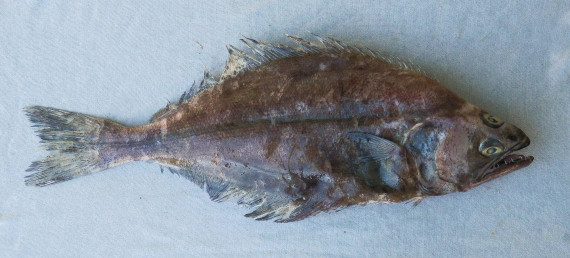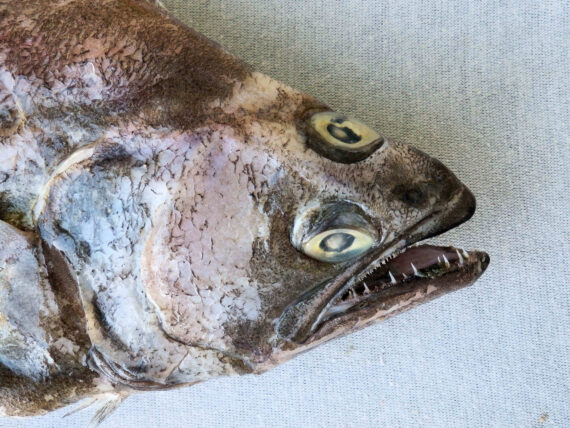Arrowtooth Flounder, Atheresthes stomias
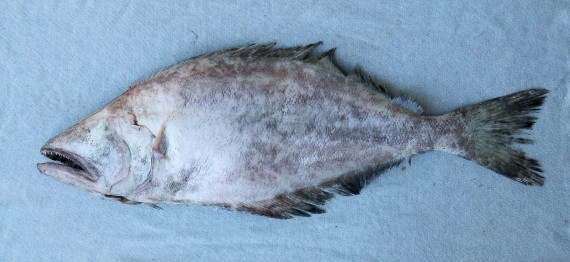 Arrowtooth Flounder, Atheresthes stomias. Fish provided by the commercial fishermen of the greater Los Cabos area, Baja California Sur, April 2013. Length: 54 cm (21 inches). Identification courtesy of H.J. Walker, Jr., Scripps Institution of Oceanography, La Jolla, California and reconfirmed by Dr. Robert N. Lea, Monterey, California.
Arrowtooth Flounder, Atheresthes stomias. Fish provided by the commercial fishermen of the greater Los Cabos area, Baja California Sur, April 2013. Length: 54 cm (21 inches). Identification courtesy of H.J. Walker, Jr., Scripps Institution of Oceanography, La Jolla, California and reconfirmed by Dr. Robert N. Lea, Monterey, California.
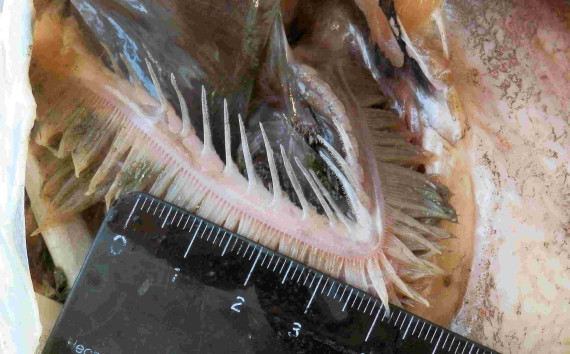 Arrowtooth Flounder, Atheresthes stomias, gill rakers. A key to the correct identification of this fish.
Arrowtooth Flounder, Atheresthes stomias, gill rakers. A key to the correct identification of this fish.
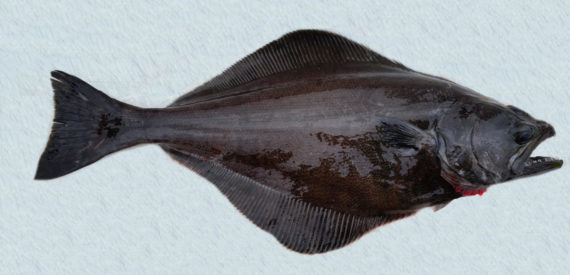
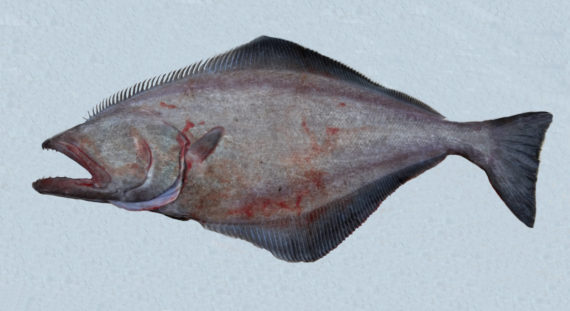 Arrowtooth Flounder, Atheresthes stomias. Fish caught from coastal waters off Sitka, Alaska, August 2017. Length: 51 cm (20 inches). Photograph and identification courtesy of Chris Wheaton, Fullerton, California.
Arrowtooth Flounder, Atheresthes stomias. Fish caught from coastal waters off Sitka, Alaska, August 2017. Length: 51 cm (20 inches). Photograph and identification courtesy of Chris Wheaton, Fullerton, California.
The Arrowtooth Flounder, Atheresthes stomias, is a member of the Righteye Flounder or Pleuronectidae Family, and is known in Mexico as platija diente fleche and halibut de Pacifico. Globally, there are two species in the genus Atheresthes, of which one is found in Mexican waters, this species from the Pacific Ocean.
The Arrowtooth Flounder has an elongated fusiform compressed body with a depth that is 33% to 37% of standard length. They are gray-brown to olive-brown on their eyed-side and off-white on their blind side. They have a very large oblique mouth that ends beyond their large eyes. Their lower and upper jaws each have 2 series of large sharp and arrow-shaped teeth. Their anal fin has 72 to 90 rays; their caudal fin is crescent-shaped or slightly lunate; their dorsal fin originates at the middle of the top eye and has 92 to 109 rays; and, their pectoral fins are very small. They have 11 or 12 gill rakers on the lower part of their anterior arch. Their lateral line is straight but curves slightly over the pectoral fin.
The Arrowtooth Flounder is a demersal species that is found over sandy and muddy bottoms at depths between 18 m (60 feet) and 670 m (2,200 feet). They reach a maximum of 86 cm (2 feet 10 inches) in length and 8.6 kg (19 lbs) in weight, with females being significantly larger than males. They are a migratory species found in shallow waters during the summer and in deeper waters during the winter when spawning occurs. They are opportunistic well-camouflaged ambush predators that lie in wait half-submerged on the ocean floor consuming crustaceans (clams, crabs, polychaetes, and shrimp) and fish (cod, herring, and pollock). In turn they are preyed upon by halibut, orcas, sea lions, seals, sharks, skates, and toothed whales. They have lifespans of up to twenty-seven years.
The known range for the Arrowtooth Flounder is from the Bering Sea to Northern California with them being common from Alaska to British Columbia. The fish photographed above is an extraordinarily rare catch from the coastal waters of Baja California Sur and of great scientific interest, found some 1,600 km (1,000 miles) out of its known range and well into the tropical Eastern Pacific Ocean.
The Arrowtooth Flounder is most likely confused with the Greenland Halibut, Reinhardtius hippoglossoides (short fat gill rakers).
From a conservation perspective the Arrowtooth Flounder has not been formally evaluated. They are very abundant and caught year-round by commercial fishermen utilizing bottom trawls in the Pacific Northwest off the coasts of Oregon, Washington, British Columbia, and Alaska including from within the Bering Sea and around the Aleutian Islands. Currently an estimated 50,000 tons are caught annually. They are heavily regulated in the Pacific Northwest, but annual catches do not exceed the established limits at present. Management of their populations is deemed to be essential for the ecosystem as they are very abundant and an important part of the food chain both as predator and prey. Their meat can quickly deteriorate if not handled properly giving them a marginal image as a food fish. To increase their marketability, they are sold as “Turbot”, which is a highly esteemed European fish. They are valued commercially for their frills and fleshy fins, which are sold as fake engawa (premium sushi). Whole fish are also exported to China where they are processed into fillets and then reimported into the United States as inexpensive flounder. If prepared properly their meat is delicate and white with a mild sweet flavor. They are also sold as fishmeal, surimi (imitation crab), and animal feed.
